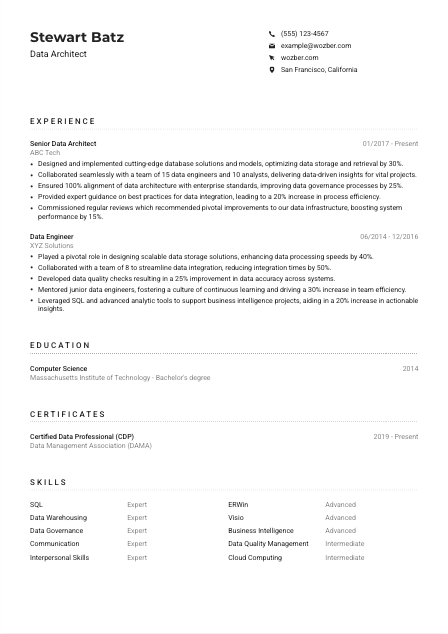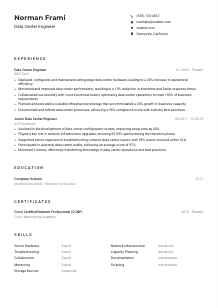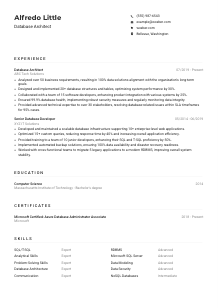Data Architect CV Example
Designing data landscapes, but your CV looks jumbled? Delve into this Data Architect CV example, structured with Wozber free CV builder. See how seamlessly you can map your data design prowess to meet job requirements, creating a career blueprint that's as integrated and efficient as your datasets!

How to write a Data Architect CV?
Embarking on the journey to secure a coveted Data Architect position? Your CV is your key to unlock opportunities, and it's essential to tailor it with precision to stand out in the competitive landscape. With Wozber's free CV builder at your disposal, this guide illuminates how to meticulously align your CV with the specific demands of your dream job. Whether you're refining data landscapes or revolutionizing data storage solutions, let's sculpt a CV that narrates your expertise compellingly, making it an irresistible pick for recruiters.
Personal Details
The introductory handshake of your CV sets the professional tone. Let's tailor this section to reflect the hallmarks of a Data Architect, ensuring it resonates with precision and clarity.
1. Brand Yourself with Your Name
Your name is your professional banner. Make it prominent, ensuring it captures attention amidst a sea of text. This is the crest of your personal brand; let it fly high.
2. Positioning for the Role
Below your name, clearly align your aspirations by stating that you are aspiring for a "Data Architect" role, mirroring the job title, showing instant relevance.
3. Perfecting Contact Essentials
Ensure your phone number and professional email (preferably in the firstname.lastname format) are error-free. A simple typo can be the barrier between you and your next opportunity.
4. Confirming Your Proximity
"San Francisco, California" isn't just a location; it's a prerequisite for this role. Display it proudly, letting employers know you're in the heart of the action without the fuss of relocation.
5. Showcasing Professional Online Presence
An up-to-date LinkedIn profile can amplify your professional narrative. Consider it an extended pitch to your CV, providing depth to your professional journey.
Takeaway
Consider this section your CV's firm handshake - it's the first step towards making a memorable impression. With these details meticulously aligned, you're poised to capture the attention of recruiters from the get-go.





Experience
The experience section is where you shine a spotlight on your journey, showcasing how each step has crafted you into the ideal candidate for the Data Architect role. Let's delve into crafting compelling narratives around your achievements.
- Designed and implemented cutting‑edge database solutions and models, otimizing data storage and retrieval by 30%.
- Collaborated seamlessly with a team of 15 data engineers and 10 analysts, delivering data‑driven insights for vital projects.
- Ensured 100% alignment of data architecture with enterprise standards, improving data governance processes by 25%.
- Provided expert guidance on best practices for data integration, leading to a 20% increase in process efficiency.
- Commissioned regular reviews which recommended pivotal improvements to our data infrastructure, boosting system performance by 15%.
- Played a pivotal role in designing scalable data storage solutions, enhancing data processing speeds by 40%.
- Collaborated with a team of 8 to streamline data integration, reducing integration times by 50%.
- Developed data quality checks resulting in a 25% improvement in data accuracy across systems.
- Mentored junior data engineers, fostering a culture of continuous learning and driving a 30% increase in team efficiency.
- Leveraged SQL and advanced analytic tools to support business intelligence projects, aiding in a 20% increase in actionable insights.
1. Deciphering Job Specifications
Pour over the job description, identifying the essential experiences such as "designing database solutions" and "collaborating with data engineers." This will guide you in highlighting the most pertinent aspects of your past roles.
2. Structuring Your Story
Adopt a reverse-chronological format, starting with your current or most recent role. Detail your title, the company's name, and the timeframe you contributed to underscore your steady trajectory in the data field.
3. Articulating Your Achievements
For each role, concisely describe how your contributions, such as "enhanced data storage and retrieval by 30%," align with the job's listed requirements. This mirroring strategy ties your past successes directly to potential future contributions.
4. Quantifying Success
When possible, bolster your achievements with numbers. Quantitative accomplishments provide a compelling narrative of your impact and enhance the persuasiveness of your expertise.
5. Focusing on Relevance
Highlight only those experiences that resonate with the Data Architect role. Extraneous achievements, no matter how impressive, might dilute the targeted focus of your CV.
Takeaway
Your experience section is not merely a list but a carefully crafted story of your evolution as a Data Architect. Embrace the power of your past projects and roles, showcasing how they've sculptured you into the ideal candidate for your dream job.
Education
Your education isn't just a set of qualifications; it's the bedrock of your knowledge in data architecture. Let's dig into optimally positioning your educational foundation to highlight its alignment with the role's necessities.
1. Identifying Key Requirements
The job asks for a "Bachelor's degree in Computer Science, Information Systems, or related field." This requirement becomes the anchor of your educational section, steering the narrative toward your relevant academic foundation.
2. Keeping It Structured
Lay out your education clearly. Start with your degree, followed by your field of study, the institution's name, and the graduation year. An orderly presentation eases the recruiter's journey through your educational path.
3. Matching Degree to Requirements
Directly align your degree with the job's stipulation. For instance, showcase your "Bachelor's degree in Computer Science" as a testament to your foundational relevance to the Data Architect role.
4. Relevant Coursework (Optional)
In instances where further specialization is beneficial, listing relevant coursework can enhance the depth of your expertise, especially in areas directly applicable to data architecture.
5. Showcasing Other Academic Achievements
For early-career individuals or when applicable, including honors, clubs, or significant projects can underscore your active engagement and prowess in the subject matter.
Takeaway
Your educational section is a declaration of your readiness and fit for the Data Architect role based on solid academic ground. Tailor it to reflect not just what you've learned, but how it prepares you for the evolution and challenges in the data landscape.
Certificates
In the evolving world of data architecture, certifications can be a strong indicator of your passion and commitment to staying current. Here's how to finely select and present certifications that bolster your candidacy.
1. Parsing Job-Related Certifications
First, understand that while the job doesn't explicitly require certifications, showcasing relevant ones like "Certified Data Professional (CDP)" significantly enhances your professional profile.
2. Prioritizing Resonance over Quantity
List certifications that are most pertinent to the Data Architect role. Too many unrelated certifications might detract from your targeted expertise. Quality shines over quantity.
3. Including Validity Dates
For certifications with expiration dates, mentioning when you achieved them or when they expire provides clarity on the currency of your knowledge and skills.
4. Staying Ahead
The tech landscape is always shifting. Regularly update your certifications and seek out opportunities to learn and grow within the data architecture field.
Takeaway
Certifications are your badges of continuous learning and expertise. They underscore your dedication to the craft of Data Architecture. Showcase them strategically to illuminate your commitment to staying at the forefront of your field.
Skills
The skills section is a quick yet potent overview of your professional arsenal. Let's adeptly craft this snapshot to reflect the high-demand skills for a Data Architect, resonating strongly with the job specifications.
1. Extracting Relevant Skills
Analyze the job description to pinpoint both hard and soft skills. It mentions "strong proficiency with SQL" and "excellent communication." These become key entries in your skills list.
2. Prioritizing Direct Matches
Your skill set should directly reflect the requirements listed in the job description. List skills like SQL, data warehousing, and data governance prominently, ensuring they align with the employer's needs.
3. Arranging with Purpose
Resist the temptation to overcrowd your skills section. Instead, strategically select the skills that showcase your qualifications for the Data Architect role, prioritizing those mentioned in the job description for maximum impact.
Takeaway
Consider each skill you list as a tool in your professional toolkit. With each entry, you're promising potential value to your future employer. Let your skills section be a testament to your readiness and your unique fit for the Data Architect role.
Languages
In a profession where comprehending and conveying complex data concepts matters, linguistic prowess can be an added advantage. Here's how to fine-tune your language skills to align with the Data Architect job requirements.
1. Ensuring Job Essential Language Proficiency
"Ability to perform job duties in English is essential" underlines the job's language requirement. Assert your proficiency in English clearly to meet this fundamental criterion.
2. Prioritizing Relevant Languages
Focus on highlighting languages essential for the job first. Your proficiency in English, being a prerequisite, should be prominently displayed.
3. Showcasing Additional Languages
Even if not directly asked, additional languages can set you apart, showing versatility and readiness for potential global or diverse interactions within data architecture projects.
4. Being Clear about Proficiency
Maintain transparency about your level of language proficiency, using terms like native, fluent, intermediate, or basic. This honesty establishes trust and sets clear expectations.
5. Understanding the Role's Scope
Consider the broader implications of the Data Architect role. For positions involving multinational datasets or cross-border collaborations, fluency in additional languages could be a significant asset.
Takeaway
Your ability to maneuver through languages enhances your capacity to navigate complex data landscapes and interact with diverse teams effectively. Treat each language as a bridge, expanding your reach and enriching your professional interactions.
Summary
The summary is your CV's opening statement, setting the stage for your narrative. Here's how to tailor this section to resonate with the essence of a Data Architect, making a compelling case for your candidacy.
1. Synthesizing the Role
Understand the core of the job position – it's all about designing innovative data solutions and ensuring their alignment with enterprise standards. Your summary should reflect this understanding.
2. Leading with Your Narrative
Start your summary with a powerful introduction, portraying yourself as a Data Architect driven by innovation and efficiency in managing data landscapes.
3. Mirroring Key Skills and Achievements
Highlight your expertise in SQL, data warehousing, and your ability to collaborate with cross-functional teams, directly linking your skills and accomplishments to the job's requirements.
4. Keeping It Crisp
Your summary is an elevator pitch, not a detailed account. Aim for a concise, punchy paragraph that grabs attention and invites the hiring manager to read on.
Takeaway
A well-crafted summary is like the cover of a book – it should intrigue and compel further exploration. Let yours be a clear reflection of your professional journey, pointing the way towards your future as a Data Architect.
Launching Your Data Architect Journey
With these principles in mind, you're equipped to refine your CV into a testament of your Data Architect prowess. Remember, your CV is not just a document; it's a narrative of your professional journey tailored to your dream role. Let Wozber's free CV builder, equipped with ATS-friendly CV templates and an ATS CV scanner, guide you in crafting an ATS-compliant CV that tells your story compellingly. Your next big role is just a CV away – start building it today!

- Bachelor's degree in Computer Science, Information Systems, or related field.
- Minimum of 5 years' experience in data management, architecture, or a related field.
- Strong proficiency with SQL and data modeling tools (e.g., ERWin, Visio).
- In-depth knowledge of data warehousing, data integration, and data governance principles.
- Excellent communication and interpersonal skills, with the ability to collaborate effectively with cross-functional teams.
- Ability to perform job duties in English is essential.
- Must be located in San Francisco, California.
- Design and implement effective database solutions and models to store and retrieve company data.
- Collaborate with data engineers and analysts to understand data needs and deliver solutions.
- Ensure data architecture aligns with enterprise data standards and frameworks.
- Provide guidance on best practices for data integration, quality, and governance processes.
- Regularly review and recommend improvements to existing data infrastructure and systems.















